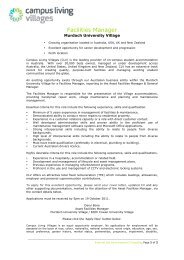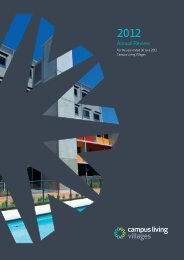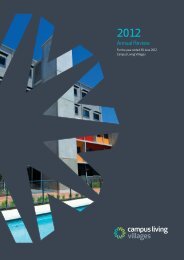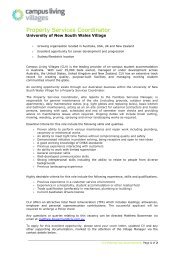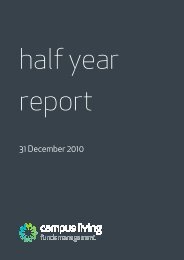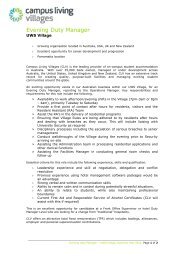Annual Report - Campus Living Villages
Annual Report - Campus Living Villages
Annual Report - Campus Living Villages
You also want an ePaper? Increase the reach of your titles
YUMPU automatically turns print PDFs into web optimized ePapers that Google loves.
<strong>Campus</strong> <strong>Living</strong> <strong>Villages</strong> <strong>Annual</strong> <strong>Report</strong> 09/10 1 9<br />
<strong>Campus</strong> <strong>Living</strong> <strong>Villages</strong> Fund<br />
NOTES TO THE CONSOLIDATED FINANCIAL STATEMENTS<br />
FOR THE YEAR ENDED 30 JUNE 2010<br />
A$’000<br />
The recoverable amount is the higher of an asset’s fair<br />
value less costs to sell and value in use. For the purposes of<br />
assessing impairment, assets are grouped at the lowest levels<br />
for which there are separately identifiable cash inflows which<br />
are largely independent of the cash inflows from other assets<br />
or Fund’s assets (cash-generating units). Non-financial assets<br />
other than goodwill that suffered impairment are reviewed for<br />
possible reversal of the impairment at each reporting date.<br />
m) Other financial assets<br />
Classification<br />
The Fund classifies its investments in the following categories:<br />
financial assets at fair value through profit or loss, loans and<br />
receivables, held-to-maturity investments and availablefor-sale<br />
financial assets. The classification depends on the<br />
purpose for which the investments were acquired.<br />
FUND<br />
k) Cash and cash equivalents<br />
For cash flow statement presentation purposes, cash and<br />
cash equivalents include cash on hand, deposits held at call<br />
with financial institutions, other short-term, highly liquid<br />
investments with original maturities of three months or<br />
less that are readily convertible to known amounts of cash<br />
and which are subject to an insignificant risk of changes in<br />
value, and bank overdrafts. Bank overdrafts are shown within<br />
borrowings in current liabilities on the balance sheet.<br />
l) Trade receivables<br />
Trade receivables are recognised initially at fair value and<br />
subsequently measured at amortised cost using the effective<br />
interest method, less provision for impairment. Trade<br />
receivables are generally due for settlement within 30 days.<br />
Collectability of trade receivables is reviewed on an ongoing<br />
basis. Debts which are known to be uncollectible are written<br />
off. A provision for impairment of trade receivables is<br />
established when there is objective evidence that the Fund will<br />
not be able to collect all amounts due according to the original<br />
terms of the receivables. Significant financial difficulties<br />
of the debtor and default or delinquency in payments more<br />
than 30 days overdue are considered indicators that the<br />
trade receivable is impaired. The amount of the provision on<br />
impairment is the difference between the asset’s carrying<br />
amount and the present value of estimated future cash flows,<br />
discounted at the original effective interest rate.<br />
Cash flows relating to short-term receivables are not<br />
discounted if the effect of discounting is immaterial.<br />
The amount of the provision on impairment is recognised<br />
in the Statement of Comprehensive Income in other<br />
expenses. When a trade receivable for which an impairment<br />
has been recognised becomes uncollectible, it is written<br />
off against the allowance account for trade receivables.<br />
Subsequent recoveries of amounts previously written off<br />
are credited against other expenses in the Statement of<br />
Comprehensive Income.<br />
Management determines the classification of its investments<br />
at initial recognition and, in the case of assets classified<br />
as held-to maturity, re-evaluates this designation at each<br />
reporting date.<br />
Financial assets at fair value through profit or loss<br />
Financial assets at fair value through profit or loss are<br />
financial assets held for trading. A financial asset is classified<br />
in this category if acquired principally for the purpose of<br />
selling in the short term. Derivatives are classified as held for<br />
trading unless they are designated as hedges. Assets in this<br />
category are classified as current assets.<br />
Loans and receivables<br />
Loans and receivables are non-derivative financial assets with<br />
fixed or determinable payments that are not quoted in an<br />
active market. They are included in current assets, except for<br />
those with maturities greater than 12 months after the balance<br />
sheet date which are classified as non-current assets. Loans<br />
and receivables are included in trade and other receivables,<br />
other current assets, receivables and other non-current assets<br />
in the balance sheet.<br />
Held-to-maturity investments<br />
Held-to-maturity investments are non-derivative financial<br />
assets with fixed or determinable payments and fixed<br />
maturities that the Fund’s management has the intention and<br />
ability to hold to maturity. If the Fund was to sell other than an<br />
insignificant amount of held-to-maturity financial assets, the<br />
whole category would be tainted and reclassified as availablefor-sale.<br />
Held-to-maturity financial assets are included in<br />
non-current assets, except for those with maturities less than<br />
12 months from the reporting date, which are classified as<br />
current assets.<br />
Available-for-sale<br />
Available-for-sale financial assets, comprising principally<br />
marketable equity securities, are non-derivatives that are<br />
either designated in this category or not classified in any of<br />
the other categories. They are included in non-current assets<br />
unless management intends to dispose of the investment<br />
within 12 months of the balance sheet date.



